OOC:
@Lord Iggy, i like your ideas. That is a cool post, im incredibly honoured you posted your 12,000th in this thread

@all, this is the last update in this style, the pictures in particular took about 3000% of the time I had originally planned for this NES... much simpler things from now on... *collapses from update exhaustion*
IC:
Era 16: The Tranic Era
This era is named after the fossils of Proto-Tranel which first appeared at this time. Fossil evidence suggests that these trees covered a large part of the planet's surface by the end of this era.
This era is also notable for the large numbers of new species that appeared. However, this was also an era of fast geological movements. The planet was getting considerably cooler and drier during this time, possibly as a result of the rising and sinking of various land-bridges, causing the shifting of ocean currents, thus causing the whole global climate to change. The distribution of plankton in the ocean also seems to have been highly erratic during this era.
New Evolutions:
(
Thriving) (
Doing good) (
Endangered) (
Extinct)
The
Energetic Zeeboo proved more successful than its ancestor, though it still didn't replace the older Multiplying Zeeboo. The Zeeboolands were also in decline during this era, for reasons discussed later...
Proto-Tranel was a great success. Its hibernating seeds and nutrient-storing roots allowed it to colonise areas of relatively dry or infertile land. Huge stretches of Fernlands and older Fanel Forests disappeared, swallowed up by the new Tranel forests. The Proto-Tranel also had the distinction of being the most genetically complex lifeform around at this time.
Floater Muncher was a strange creature of unknown origin, perhaps related to the same microscopic ancestors as the Finners or Omis. It is believed that it first evolved in some isolated lake, before finding its way into the greater ocean. It had a simple but effective way of feeding. Although completely helpless and defenceless if spotted, it was able to hide amongst the sea plants for shelter.
Yuckius Trappus replaced the earlier Yuckius Jawus. The lure proved a useful accessory for its laid-back lifestyle. It was now much more of a threat to faster animals like the Cloudfish and Redfish. It was also beginning to compete with the Tentaluxus Alertus (the latest descendent of the ancient Tenta line), which had a very similar style of hunting.
The versatile
Sandavalion was present across large stretches of land, from coastal regions to drier plains. It was the most efficient walker and runner yet seen. However it remained something of a fringe species. Its speed was not such a great advantage for hunting, as its prey remained rather slow. Its speed was more useful for escaping the Viparix and Keldot. The Sandavalion inherited the strong bite of its predecessors, but still generally had trouble tackling the crawling animals, which were both well armed and armoured. It could only really hunt the young or sick. It could still swim and hunt underwater too, and this was useful, but the species was no longer as graceful in the water as its ancestors had been. It still remained confined to warmer regions also.
Efficient Finner prospered, simply put. One fully grown, its speed and stamina made it a very frustrating target for any contemporary predators. At a time when plankton levels were varying all over the place, plants were a more reliable food source. The species continually spawned in huge numbers, and the eggs and young were an important food source for many other species.
Jubblerus Insanicus became well established in the tropical forests, and also began venturing further inland. Its sticky poison spit was able to deter predators. It could also be used aggressively, to bring down vulnerable animals. However this species was not yet a true hunter, as it could only digest rotting flesh, and had to wait for its victims to start decomposing before it could get a meal, during which time other predators and scavengers would be attracted... It was also rather slow-growing and slow-breeding, due to its increasing energy demands.
Sadly, the
Finner Stalker didn't survive this era. Although surviving in isolated areas for some time, it was not particularly well adapted to life further inland, or hunting other animals. Its main weapon was a comparatively-weak bite, which had little chance of defeating any of the main land species (even the sick and injured). The claws of the Terradids and Land Quintupler's often kept it away from the best foraging areas. Meanwhile the Finner Stalker's ancestor, the LungScraper, was still alive and well by the end of this era, as it kept to a more amphibious lifestyle away from the dangerous land animals.
Shellster Velenopod became well established, but didn't really thrive - mainly due to competition with its predecessor. Increased defences (piercing poison-tipped spikes) and mass reproduction were somewhat counter-productive, in terms of the extra energy demands they created. Although the Velenopod was now all but immune to attack, the older Shellster Spitzepod species was still able to deter most predators, and was able to survive on slightly fewer amounts of plankton, which became important as plankton levels fluctuated from year to year.
The descendents of the Venatoryte remained divided into two separate lines. The
Keldot took over as the king of the tropical Fanel Forests, and was unique in developing an internal skeleton while keeping its old exoskeleton too. Despite its rather complicated physiology (and thus slower growth rates), it still had a combination of weapons, armour and strength that was unbeatable.
The
Viparix was much more widespread and numerous by comparison. While it lived a more cautious life in the tropical forests, it was the top predator in most other land habitats. The sense of smell and pack-hunting instincts worked particularly well across the vast stretches of Fernlands. The evolution of live birth was something of a mixed blessing, brining extra energy demands on the adults, but did at least allow for more time spent hunting, as opposed to guarding eggs.
The
Land Quintupler was a most unwelcome intruder onto land. It stepped on the toes of many other species. Within a short space of time (in evolutionary terms), this very versatile and comparatively-intelligent had spread throughout all the continents, and had become established far inland. However, it was not particularly great at any one thing (the Terradid MkIIs still had the advantage as simpler and more efficient plant eaters, for example). So although widespread, it did not have vast populations in any one area.
After a little more evolutionary adjustment, the
Socivalion Mrk IV emerged as the top ocean predator (and also happened to be the most genetically complex animal of the time). The Grey Hunter was firmly consigned to second place, though that species was hardly endangered yet (the Greys had the advantage in nocturnal hunting especially).
The
Scalavalion emerged as the arch nemesis of the Cavorytes, at least in the coastal areas. Although not able to dig as deep as the Cavorytes, it was still able to hunt them more effectively than any other predator. It had other small animals on its menu, too, and was starting to out-compete the Beakvalion in many areas (a similar species which had evolved in the previous era). Its burrowing skills also proved useful for providing shelter and protection from other land animals - not that it was particularly vulnerable otherwise, having a strong bite and the new addition of scales on its skin. However, it was limited by the poor efficiency of its digestive tract at handling meat, and currently could only survive in the warm, wet climates.
The
Infil-Cult successfully fought back against the Wormfish, with its adaptations for surviving stomach acids, allowing its larvae a new avenue of attack against its predators. Infil-Cult infestation caused the deaths of countless animals in the oceans. Still, in the end, it was just one of the many factors of life that tended to weed out the weaker animals.
(NPC evolutions: )
Planktonus Frigidus evolved to survive in the coldest waters, where predators were fewer - which was fortunate, as the original species was finally eaten into extinction during this era.
Garbageos Megatronus was another creature quietly surviving in the warm seas, not really notable for anything.
Great Hunter was the largest predator ever seen in the ocean. Especially frightening when hunting in a pack, it was able to prey on any other animal in the right situation. But, although the biggest, it was not quite top of the food chain, and could itself be vulnerable to gangs of Socivalions in particular. Its numbers remained fairly low, and they had to continually trek across the ocean in search of enough prey to meet its appetite.
The
Redfish was just an evolution of the Cloudfish, with improved eyesight, and gills that could be officially classified as such. It was slowly replacing the Cloudfish in many areas of the ocean, but not everywhere - some situations still favoured the slightly-simpler Cloudfish, especially as plankton levels remained erratic.
Hiboryte took the Cavoryte line of evolution further inland. With more resistance to dry conditions, and the ability to hibernate through really bad times, the Hiborytes were able to colonise large areas of the Fernlands.
The
Swamp Amph became established in coastal areas, but was still poorly adapted for life on land, and remained closely tied to the water.
Old Species:
The
Clepsurytes benefited more than most form the spread Tranel forests.
The
Super Yucky Finner struggled on for yet another era, its fortunes still running dangerously low.
There was still enough room for most plants, but the
Terranoplan had fewer numbers than most.
After struggling for millions of years, the unique
Jet-Spike sadly went extinct.
The
Giganto Leafworm (a relic from the days of the isolation of the Orospeh subcontinent) finally went extinct.
The
Respiryte was finally squeezed out of existence by its various descendents. This species has the distinction of giving rise to several new branches of evolution.
The
Planktonus Maximius was simply too vulnerable to last in the warm waters, though its descendents are still surviving in the polar waters.
New evolutions caused all other extinctions:
Singing Zeeboo,
Yuckius Jawus,
Landavalion,
Bloom Finner,
Jubblerus Poisospitta,
Dolosyte,
Nekes,
Socivalion Mrk III,
Packcult, and
Garbage-Seeker
Planet Map:
Just a few million years after joining together, the subcontinents of Oroseph and Zerith broke apart again. Orospeh then fused with the larger eastern continent instead.
By the end of this era, all the continents had been separated into two groups, known as Agonia and Caliburn. Though all the land animals that emerged during this time were able to colonise both halves before the split became too wide.
The Zeeboolands were a victim of their own success. After millions of years of eating away at the rock, they tended to build up a layer of soil which other hardy plants could colonise. So, while the emerging Tranel Forests ate up much of the Fernlands, the Zeeboolands were in turn converted into Fernlands or forests of various types. Though the Zeeboos were by no means in danger of going extinct, it seemed like the days of endless 'forests' of nothing but Zeeboos were coming to and end...
Warm Shallows:
Cold Shallows:
Remains very similar to the warm shallows generally, though still has the richest sources of plankton.
Open Ocean:
Ocean Floor:
No real changes occurred during this era, so we shall not dwell here...
Zeeboolands:
An invasion is occurring, as various plants take advantage of all the Zeeboo's hard work. But the climate in these parts is still a little too dry for most animals. Terradids have a peaceful refuge here, but Zeeboos are not so pleasant to eat.
Fernlands:
More diversification.
Fanel Forests:
Yet more diversification.
Tranel Forests:
Basically, the cold version of the Fanel Forests, with only a few of the species seen in the warmer climates. But for those that can survive here, these lands are just as bountiful, if not more so.
Bonuses:
Plant award: Energetic Zeeboo.
Fulton gets +1 gene bonus.
Animal award: Efficient Finner.
erez87 gets +1 gene bonus.
Innovation award: Proto-Tranel.
TerrisH gets +1 gene bonus.
Survival award: Bathyscaper.
North King gets +1 gene bonus.
Story award: Lord_Iggy gets +1 gene bonus.
Reminder: Species locked against evolution!
As mentioned before - From now on, you cannot evolve from other people's species unless they give permission!
However, older species will still be evolve-able by everyone. That is, anything older than 3 updates, which is now from era 13 or before.
Some New Genes appearing in this era:
Strength - I have a feeling I disallowed this at some point earlier, but now it think a generic 'strength' gene could be useful. Sorry for that. Anyway, I see this as when an animal has extra-strong muscles, or something, which gives it greater strength that it probably needs for everyday tasks (like moving around), but can give it an advantage in a fight, or give some other random advantages (like maybe tearing down trees or something).
*Continental Seperation:*
The land surface has split up again. For any new land animals, you may wish to specify whether you want to start on 'Agonia' or 'Caliburn', or I will randomly decide where it appears.
Species Stats: (please check before evolving etc)
The stats list is ever-increasing in size, at least until the next mass extinction

evil

. I still haven't though of something better, so I've attached the stats in both .txt and word .doc formats: (same stuff in each file, though the word doc is maybe a bit easier to read through, if you can open it)







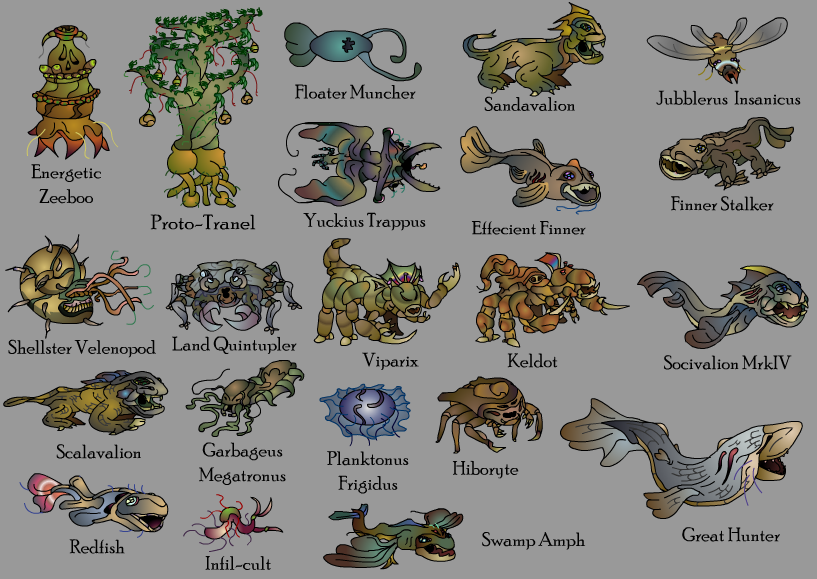

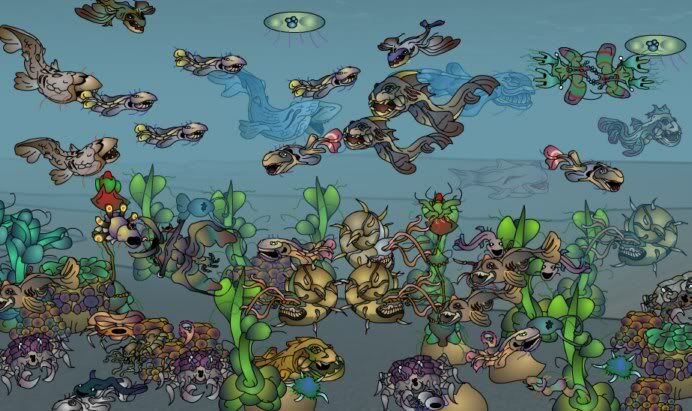

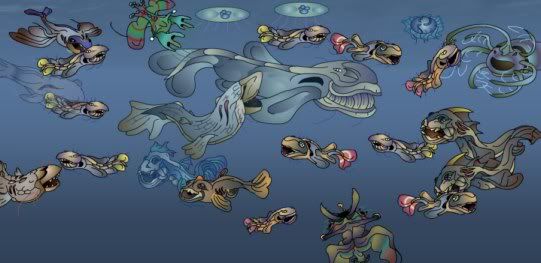
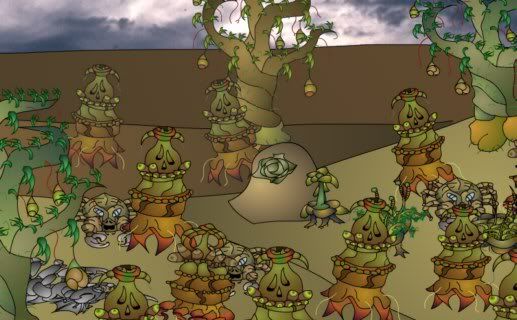
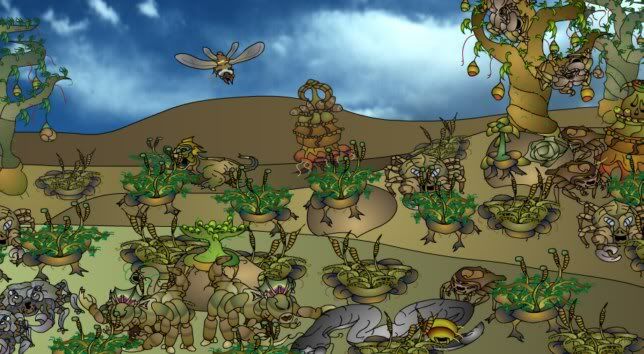
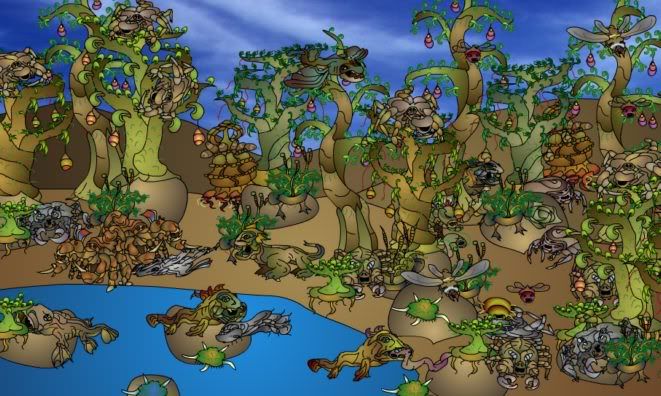
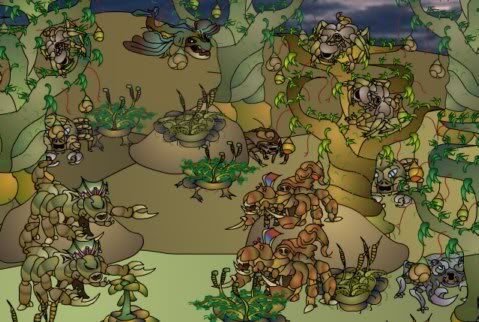
 evil
evil
 So go sleep off the update tiredness.
So go sleep off the update tiredness.
 ) On his exploration of a misterous planet:
) On his exploration of a misterous planet: